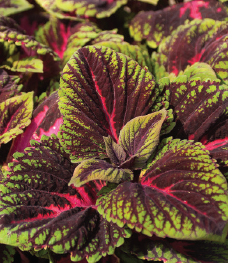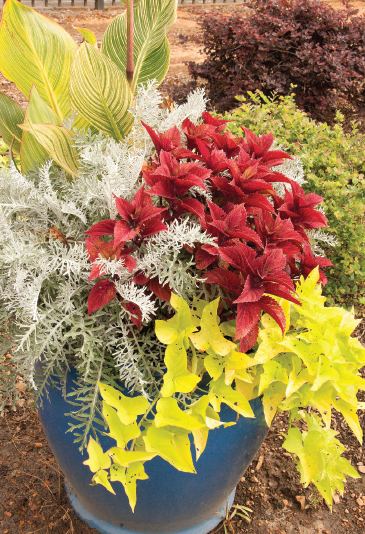Potted plants are the perfect solution for adding instant botanical interest to a sidewalk, porch, patio or deck this summer, and while they tend to be low maintenance, there are plenty of simple tricks to fine-tune the art of keeping these contained creations alive, well and showing off through the summer months. Below are a few such pointers for your potting pleasure:
- Clay pots are popular because their weight permits many plantings to grow large but not top-heavy. However, remember that such planters also allow more evaporation through the sides than plastic pots, so they need to be watered more often.
- Mixing SAP (Super Absorbent Polymers) with the soil lessens the need to water plant containers so often. SAP products can usually be found at garden shops, but the soil can also be pampered, literally. Simply place a clean absorbent diaper such as a Pampers plastic side down 6 to 12 inches (depending on the size of the plants) under the dirt in the pot and make a few cuts to expose the moisture-retaining polymer flakes.
- The more a container is watered, the quicker plant nutrients are leeched out of the soil, so make it a habit during the growing season to substitute plain water with a diluted fertilizer solution every two to three weeks.
- Many summer containers are filled with sun-worshiping plants, but in such small spaces, too much of Ol’ Sol is not necessarily a good thing. To moderate the solar sizzle, try placing pots where they will be shielded from the worst of the sun’s rays in the late afternoon. Also, keep in mind that light-colored pots reflect more light — as well as heat — than dark containers, and in doing so, help keep the enclosed root system cooler.
- To visually soften the rims of the pots, think about including such wandering plants as lysimachia, creeping thyme, ornamental sweet potato or even mint that will readily, playfully flow down the sides. On a practical side, this creative plant covering also acts a living mulch to deflect sun rays from the container’s soil, which helps keep the enclosed dirt cool and prevents the loss of moisture.
- A large planter doesn’t have to be a heavy planter. To make it less of a beast to move around, add Styrofoam peanuts to the bottom quarter to third of the container and then finish filling with potting soil.
- When it comes to dirt for planters, always use a quality product. Thick, heavy bags normally labeled “Garden Soil” might be way less expensive than a good potting soil mix, but this kind of dirt makes a container much heavier than it needs to be. It also turns to goo when over-watered and a brick when dried out too much, making it a rather hostile medium for developing plant roots.
L.A. Jackson is the former editor of Carolina Gardener Magazine. Want to ask L.A. a question about your garden? Contact him by email at: lajackson1@gmail.com.
To Do in the Garden
June
If you weed the old-fashioned way by hand, remember the best way to prevent even more weeds is to pull the pesky plants before they develop seed heads.
Flea beetles love hot weather, and they also love eggplants, so watch for these pin-sized pests. Contact insecticides can be used, but draping the plants with lightweight row cover fabric is a non-chemical, effective way to deter these unwanted insects. Row covers are also a good way to prevent stink bugs from marring maturing tomatoes.
Dry, hot weather can cause blossom drop on peppers, so during long spells of arid conditions, maintain mulch layers, irrigate regularly and even mist the plants’ foliage once or twice a day with water.
If you insist on battling Japanese beetles with bait traps, since they usually attract more of these bad bugs than would normally fly into the yard, place these attractants far, far away from plants that are susceptible to being damaged by them.
July
When the blooms of daylilies are past their prime, snip the flowers to prevent energy from going into seed production. However, leave the foliage until it fades. Just as spring bulb plants, these summer beauties continue to store energy through their leaves to help produce even more flowers next year.
It is not too soon to be thinking of the cool weather garden. Sow pots of pansy seeds indoors or in a protected outdoor location now to have them in shape for transplanting to flower beds this fall.
Don’t mow the lawn when it is wet! This not only results in an uneven, ragged cut across the surface, but it also encourages the spread of grass diseases.
Have you made any mud lately? Fill a large, shallow bowl such as an old birdbath with about an inch of dirt and add water until it is the consistency of yuck. Then, water it occasionally to keep the mud from drying out, and watch how many butterflies flit in for the moisture and minerals found in the wet dirt.
 Timely Tip
Timely Tip
Eye-catching colors can be fleeting in the summer garden, but blooms aren’t the only element that can show off visual pizzazz in the landscape. In particular, consider any of the many selections of sun coleus (Solenostemon scutellarioides) with foliage that varies in visual impact from fancy to floozy.
Purple, red, bronze, pink, copper, chartreuse, orange, yellow, scarlet, salmon — these and other hues are the colors of the many widely available sun coleus cultivars. Whether in a potted planting or flower bed, these 18- to 36-inch tall, sun-loving annuals can be counted on to bring the brightest of the rainbow to the summer landscape until the first frosts of autumn.







